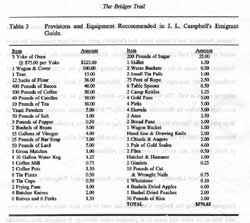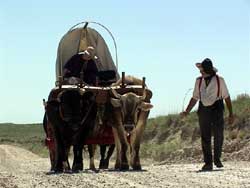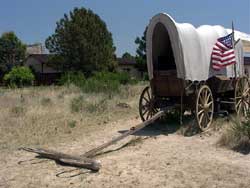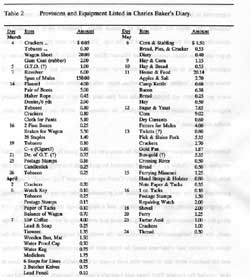|
After
making the initial decision to pull up stakes and leave familiar
surroundings, emigrants traveling to the gold diggings in Idaho
and Montana in the early 1860s still had to make serious decisions
regarding the type of outfit to put together. Should they use horses, mules, or oxen? What type of equipment would they use, and
how much and what type of provisions should they stow in the wagon
for a trip that could take up to four months to complete? It was
thought that important accouterments for a successful trip included
a trail diet that prevented scurvy, essential provisions to last
until harvest the following year after arriving at their destination,
and sufficient firearms and ammunition. To aid the emigrant unfamiliar
with trail travel across the plains, several emigrant guidebooks
had been published since 1848 by Mormon emigrants and California
gold rushers alike. These included a new guidebook published in
time for spring departures in 1864. An example of recommended equipment
and provisions is provided in the Table.
horses, mules, or oxen? What type of equipment would they use, and
how much and what type of provisions should they stow in the wagon
for a trip that could take up to four months to complete? It was
thought that important accouterments for a successful trip included
a trail diet that prevented scurvy, essential provisions to last
until harvest the following year after arriving at their destination,
and sufficient firearms and ammunition. To aid the emigrant unfamiliar
with trail travel across the plains, several emigrant guidebooks
had been published since 1848 by Mormon emigrants and California
gold rushers alike. These included a new guidebook published in
time for spring departures in 1864. An example of recommended equipment
and provisions is provided in the Table.
The type of team and wagon to chose
was one of the most important decisions that  had
to be made, and one that required serious consideration. By the
early 1860s, there were several companies in the East that had
experience making wagons for rugged travel across the plains and
mountains. Still, even wagons constructed with the best craftsmanship
and hardwoods often broke down under the rigorous demands of western
trail travel. The wagons made in the 1860s were hybrids of the
original Conestoga wagon developed in the eighteenth century by
the Pennsylvania Dutch. Two of the most popular makes of wagons
were manufactured by Joseph Murphy's company in St. Louis, and
those made by the Studebaker brothers in South Bend, Indiana.
These were preferred for overland emigrant travel versus larger
models such as the Carson wagon used in heavy freighting. The
Murphy and Studebaker wagons were custom made according to individual
owner specifications, and could cost from $500 to $1,000. The
Studebakers advertised that a member of the company had travelled
west and therefore knew how to build wagons for emigrants. The
Stanfields and Bartletts were family friends of the Studebakers.
For Howard Stanfield, it was only natural that he headed west
in a Studebaker wagon. had
to be made, and one that required serious consideration. By the
early 1860s, there were several companies in the East that had
experience making wagons for rugged travel across the plains and
mountains. Still, even wagons constructed with the best craftsmanship
and hardwoods often broke down under the rigorous demands of western
trail travel. The wagons made in the 1860s were hybrids of the
original Conestoga wagon developed in the eighteenth century by
the Pennsylvania Dutch. Two of the most popular makes of wagons
were manufactured by Joseph Murphy's company in St. Louis, and
those made by the Studebaker brothers in South Bend, Indiana.
These were preferred for overland emigrant travel versus larger
models such as the Carson wagon used in heavy freighting. The
Murphy and Studebaker wagons were custom made according to individual
owner specifications, and could cost from $500 to $1,000. The
Studebakers advertised that a member of the company had travelled
west and therefore knew how to build wagons for emigrants. The
Stanfields and Bartletts were family friends of the Studebakers.
For Howard Stanfield, it was only natural that he headed west
in a Studebaker wagon.
A custom crafted wagon might be more
comfortable and better designed for storing items and sleeping, but a basic farm wagon of simple design often
proved to be easier to dispose of once emigrants reached their
destination, where, by selling equipment they no longer had use
for, they could raise the capital necessary to begin establishing
winter quarters. In his 1864 guide book, J. L. Campbell suggested
that, "As to a wagon, it does not require an expensive one;
just such a one as a farmer would select to do his farm work (a
common lumber wagon) is the most suitable. This kind will meet
with ready sale in the mines, whereas more expensive wagons with
springs and stationary covers are in less demand." As Campbell
suggests, many emigrants used ordinary, and in many cases, homemade
wagons.
items and sleeping, but a basic farm wagon of simple design often
proved to be easier to dispose of once emigrants reached their
destination, where, by selling equipment they no longer had use
for, they could raise the capital necessary to begin establishing
winter quarters. In his 1864 guide book, J. L. Campbell suggested
that, "As to a wagon, it does not require an expensive one;
just such a one as a farmer would select to do his farm work (a
common lumber wagon) is the most suitable. This kind will meet
with ready sale in the mines, whereas more expensive wagons with
springs and stationary covers are in less demand." As Campbell
suggests, many emigrants used ordinary, and in many cases, homemade
wagons.
Oxen were the draft animals most
commonly used on the northern plains and intermountain region
by large freight companies such as Russell, Majors, and Waddell.
Oxen were less expensive, required less feed, and were less likely
to stray or be stolen by Indians. However, many emigrants used
horses or mules as their team of choice.
As his train was about to depart the Bridger Trail cutoff, Ethel
Maynard noted that there were "about 100 wagons more horse
and mule teams than there were of ox teams."
Horses and mules moved along the
trail at a faster pace than oxen. In several places, Maynard wrote
that those travelers with horse and mule teams wanted to  continue
on, rather than wait for the slower, but sure-footed oxen. As
his train descended the Bridger Mountains, "It was some trouble
for the train to keep together as the horse and mule teams wanted
to go ahead and would travel a little faster than the cattle [oxen]
But they did not feel safe to leave the train that is those who
had cattle. . . ." The Bighorn River crossing "divided
our train as the horse teams got over first and went on and left
the cattle men. We did not get our wagon over until the second
day." continue
on, rather than wait for the slower, but sure-footed oxen. As
his train descended the Bridger Mountains, "It was some trouble
for the train to keep together as the horse and mule teams wanted
to go ahead and would travel a little faster than the cattle [oxen]
But they did not feel safe to leave the train that is those who
had cattle. . . ." The Bighorn River crossing "divided
our train as the horse teams got over first and went on and left
the cattle men. We did not get our wagon over until the second
day."
Charles Baker kept a record of the
purchases he made as he outfitted himself for the trip to Montana. He kept a rough ledger account record in his
diary that showed the price of various equipment, commodities,
and merchandise available in the Mid-western
United States during the 1860s. Baker purchased his initial supplies
for the trip to Virginia City between March and May, 1864 for
approximately $310. All of the articles, the quantity, price,
and date of purchase are given in the Table.
trip to Montana. He kept a rough ledger account record in his
diary that showed the price of various equipment, commodities,
and merchandise available in the Mid-western
United States during the 1860s. Baker purchased his initial supplies
for the trip to Virginia City between March and May, 1864 for
approximately $310. All of the articles, the quantity, price,
and date of purchase are given in the Table.
|
 |